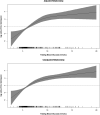Fasting Blood Glucose and COVID-19 Severity: Nonlinearity Matters
- PMID: 33051331
- PMCID: PMC7770269
- DOI: 10.2337/dc20-1941
Fasting Blood Glucose and COVID-19 Severity: Nonlinearity Matters
Abstract
Objective: Fasting blood glucose (FBG) could be an independent predictor for coronavirus disease 2019 (COVID-19) morbidity and mortality. However, when included as a predictor in a model, it is conventionally modeled linearly, dichotomously, or categorically. We comprehensively examined different ways of modeling FBG to assess the risk of being admitted to the intensive care unit (ICU).
Research design and methods: Utilizing COVID-19 data from Kuwait, we fitted conventional approaches to modeling FBG as well as a nonlinear estimation using penalized splines.
Results: For 417 patients, the conventional linear, dichotomous, and categorical approaches to modeling FBG missed key trends in the exposure-response relationship. A nonlinear estimation showed a steep slope until about 10 mmol/L before flattening.
Conclusions: Our results argue for strict glucose management on admission. Even a small incremental increase within the normal range of FBG was associated with a substantial increase in risk of ICU admission for COVID-19 patients.
© 2020 by the American Diabetes Association.
Figures

References
-
- Benfield T, Jensen JS, Nordestgaard BG. Influence of diabetes and hyperglycaemia on infectious disease hospitalisation and outcome. Diabetologia 2007;50:549–554 - PubMed
-
- Leibovici L, Yehezkelli Y, Porter A, Regev A, Krauze I, Harell D. Influence of diabetes mellitus and glycaemic control on the characteristics and outcome of common infections. Diabet Med 1996;13:457–463 - PubMed
MeSH terms
Substances
LinkOut - more resources
Full Text Sources
Medical

